In Memory of Kazimierz J. Woliński
Flying Officer P-0722 of the Polish Air Force in Great Britain
(1910 Poland - 1941 France)
by Andrzej Loesch
The intention of this brief story is to present a few events from Kazimierz Jan Woliński’s short life including his involvement in actions as a Flying Officer (F/O), in the Royal Air Force (RAF) and Polish Air Force (PAF) in Great Britain during WWII.
As a matter of introduction I should point out that Kazimierz J. Woliński, a Polish national, was my second cousin but I have never met him as I was born nearly a decade after his death; he died in September 1941 in action over France. I knew his mother – Petronela (Nela) Woliński (née Gawron), but I knew Kazimierz’s brother Mieczysław Woliński better, and called him an uncle. Our family relationship was through my mother’s mother Ewa Szczepanowska (née Gawron), who was the sister of Kazimierz and Mieczysław Woliński’s mother – Nela. Their father was Michał Woliński. There were occasions in my childhood when Mieczysław Woliński, who lived with his mother and his wife Stanisława in Katowice in Polish Silesia, would visit us in my town of birth, Nowy Sącz (Kraków Voivodship), southern Poland and talk about his brother Kazimierz. On one such visit, when I was just a few years old, Mieczysław Woliński presented me with a football. It was the first proper leather football I had.
When I was much older and starting my research visits to UK from Poland, Mieczysław Woliński asked me to find information about his brother Kazimierz, in particular in relation to his life, and his death at the age of just only 31over France in September 1941. Now, when the Woliński brothers, their parents and my parents are no longer with us, I hope they would accept this brief story about Kazimierz J. Woliński.
The story, which is presented below, is primarily based on the documents that I and my mother obtained from the Ministry of Defence APC Polish Enquiries office at RAF Northolt, UK, in November 2004 [1]. These describe the military service of: P-0722 - Flying Officer (F/O) Kazimierz J. Woliński. They also include the 'Zeszyt Ewidencyjny' the record of his education, training, and his professional military service including his journey to France from Poland in 1939, written and signed by Kazimierz J Woliński on 11 October 1939 in Paris, France. Needless to say that the Polish Armed Forces faced tremendous tasks at the brink of WWII as Poland stood alone to defend its territory and its multi-ethnic population (Polish, Ukrainians, Jewish, Belarusians, Poles of German descent, Russians, Romanis and others), using rather modest military means compared to those of the aggressors.
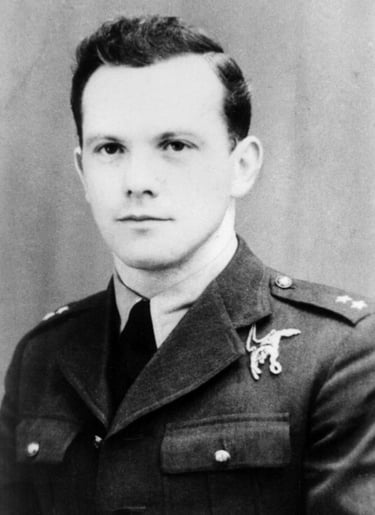

Officers’ Cadet School of the Artillery Reserve in Włodzimierz Wołyński, Poland (now Volodymyr-Volynskyi in north-western Ukraine). Officers at the barracks square during the solemn oath in 1930. Public domain. Credit (Photo): [2]
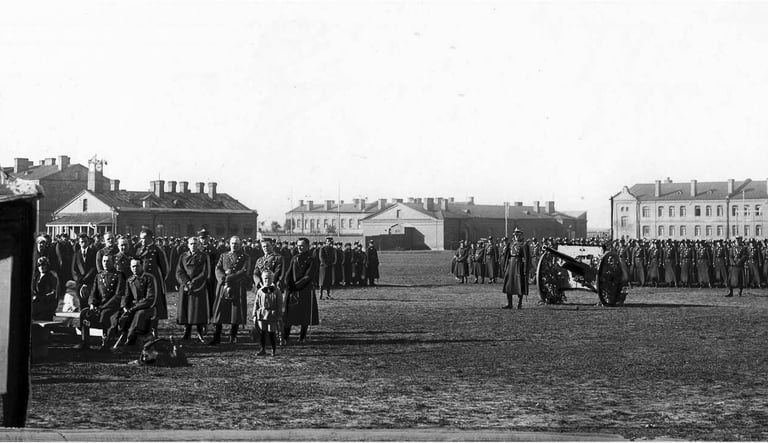

K.J. Woliński passed the mature exam (equivalent of English A levels) at the state grammar school in Stryj (south of Lwów in south-eastern Poland; now western Ukraine) in March 1931. As well as studying the usual school subjects and the Polish language, Woliński was familiar with written and spoken German.
Nisko, a small town in southern Poland, the birthplace of Kazimierz J. Woliński. Left: current view of Roman Catholic parish church Sanctuary of St. Joseph Family Guardian. Right: Monument of Freedom dedicated to Nisko’s citizens who fell or were murdered for freedom in 1939-1956.
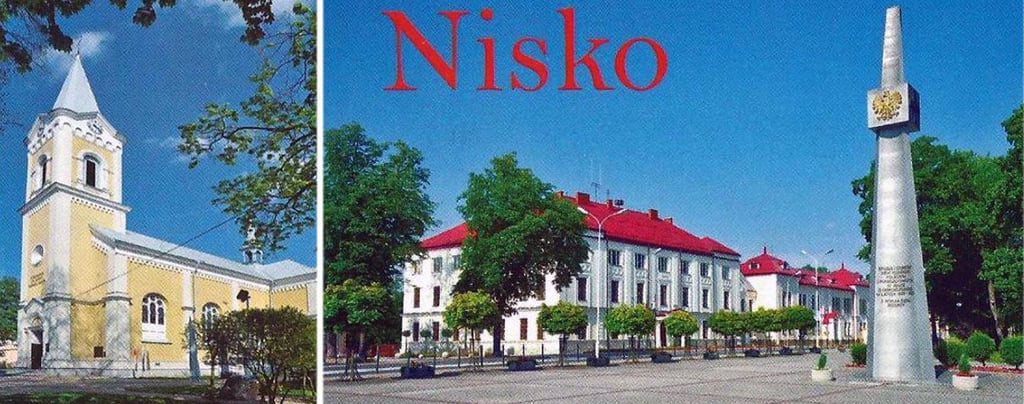

Early life: education, professional training, and pre-war military service
Kazimierz Jan Woliński was born on 12 May 1910 in Nisko, Lwów Voivodship, then part of partitioned Poland in Austrian Galicia, as the son of Polish Roman-Catholic nationals Michał Woliński and Petronela/Nela née Gawron.
Polish Military - Artillery
The 15th of July 1931 was the starting date for K.J. Woliński’s operational military service, as on that date he joined the Officer Cadet School of Artillery Reserves of 7th Battery in Włodzimierz-Wołyński (then Volhynian Voivodship of the south-east region of Poland; now Volodymyr-Volynskyi in western Ukraine). Here he was nominated from cadet to gunner, bombardier, corporal and then platoon leader.
In 1931 K.J. Woliński was promoted to gunnery sergeant (GySgt.) at 5th Regiment of Light Artillery in Lwów, Poland (now western Ukraine), and subsequently he became commander of an artillery squad there.
In January 1932 K.J. Woliński joined the Officer Cadet School of Artillery in Toruń, northern Poland, where he served at the School’s 1st Battalion. He completed the School course as a professional officer cadet in 1933.
In 1932 K.J. Woliński also served as commander of a platoon of 11th Light Infantry in Stanisławów, south-eastern Poland (now Ivano-Frankivsk in western Ukraine).
On 19 March 1934 K.J. Woliński was promoted to a second lieutenant (2Lt.) at Toruń’s Officer Cadet School of Artillery, and subsequently posted to the 22nd Light Artillery Regiment in Przemyśl, south-eastern Poland.
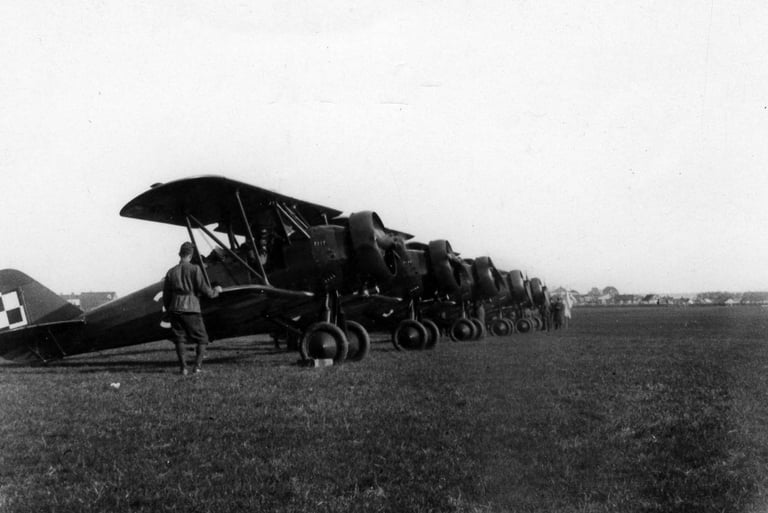

Airfields of the Polish Air Force Officers’ Training Centre (CWOL) in Dęblin in the historic province of Lesser Poland. Note the PWS biplane trainers (PWS-26) designed and developed by the Podlasie Aircraft Factory (PWS) in north-eastern Poland. A few types of the plane were produced, and for instance the PWS-16 could also be armed, while the PWS-14 was a typical trainer plane. Note that between June 1934 and June 1935 K.J. Woliński attended a pilot course at CWOL. Photo was taken on 9 May 1937. Public domain. Credit: [3,4].
On 24 October 1935 2Lt K.J. Woliński was assigned to the 4th Air Regiment in Toruń. Initially he was assigned to the 42 Reconnaissance Escadrille (squadron); RWD8 aircraft were used as trainers, and PZL.23/III Karaś as light bombers.
From 1 May to 15 July 1936 2Lt K.J. Woliński attended a higher pilotage training course in the Officer's Flight School in Grudziądz in northern Poland, which he completed with very good results. Then from 15 July 1936 to 15 October 1937, he was assigned as Pilot Officer (Plt/O, 2Lt/O) to the 141 Fighter Squadron of the 4th Air Regiment in Toruń.
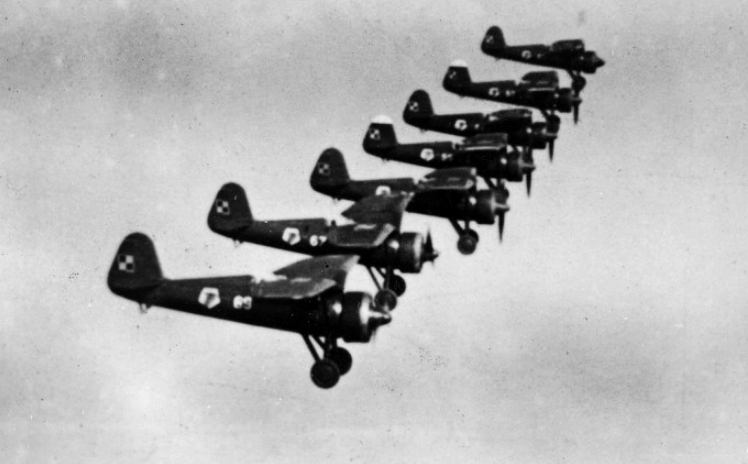

Note PZL P.11 fighter aircraft formation. This type of aircraft (of Polish design and manufactured by the State Aviation Works in Warsaw) served as primary fighter aircraft in defence of Poland during the September campaign 1939. Here this formation of seven aircraft (III/4 Dyon) was established by the following Polish pilots of 141 Fighter Squadron (from top aircraft): mjr. pil. (Sqn/Ldr) Leopold Pamuła; por. pil. (F/O) Jerzy Słoński; ppor. pil.(Plt/O) Zygmunt Kinel; ppor. pil. (Plt/O) Jan Falkowski; ppor. pil. (Plt/O) Stanisław Skalski (Poland’s most successful fighter pilot and fighter ace in the Battle of Britain); ppor. pil. (Plt/O) Anatol Piotrowski; ppor. pil. (Plt/O) Kazimierz J. Woliński. It is not clear exactly when and where the photo was taken. It seems, however, that it was taken between July 1936 and October 1937, when K.J. Woliński was assigned to 141 Fighter Squadron of the 4th Air Regiment (III/4 Dyon) in Toruń - meaning that it was before his promotion to lieutenant pilot (F/O), and before he became the second in command of the 152 Fighter Squadron of the 5th Air Regiment (III/5 Dyon) in Wilno. It is likely that the photo was taken on 6 August 1936 in Warsaw’s Okęcie Airport during the Air Show of the Armed Forces and Inspection by Edward Rydz-Śmigły – the Inspector-General of the Armed Forces. In any case the photo was taken over 70 years ago – before the WWII - hence it is in the public domain. Credit (Photo): [5]. For more details also see: [6-8]
In 1937 K.J. Woliński also completed a military glider course (possibly lasting 6 weeks) obtaining “C” category distinction (the badge portrayed silhouettes of 3 seagulls on a blue background) as a glider pilot at a well-established Glider Military Camp in Ustjanowa Górna, a village close to the Bieszczady Mountains in south-eastern Poland.
From 15 October 1937 K.J. Woliński was assigned to Dyon III/5 (Division III/5), to join 152 Fighter Squadron of the 5th Air Regiment in Wilno, Poland (now Vilnius – capital of Lithuania); the Squadron was stationed at Wilno-Porubanek Airport until 3 September 1939.
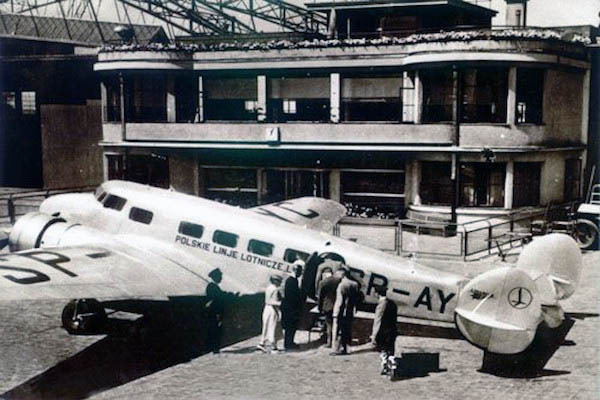

Photo shows Porubanek Airport in Wilno, where in October 1937 K.J. Woliński was assigned to Dyon III/5 - to join 152 Fighter Squadron of the 5th Air Regiment in Wilno, Poland. Unfortunately no photo of 152 Squadron at this Airport was found. Note that the airfield at this location was in use at least since 1917, but the more official use, as an airport, is attributed to the date 17 August 1932, when Polish, Latvian and Estonian officials, including the President of Poland Ignacy Mościcki, Premier of Latvia Marġes Skujenieks, and the Head of the Estonian State, opened a passenger flight connection Warsaw-Wilno and also further to Riga (Latvia’s capital) and Tallinn (Estonia’s capital). Credit (Photo): [9].
On 15 October 1937, K.J. Woliński became the second-in-command of 152 Fighter Squadron. Then on 19 March 1938 he was promoted to lieutenant (F/O); and from 1st July (or 28th August) 1939 to the 3rd September 1939 he also was a tactical officer of 152 Fighter Squadron.
From 28 August - to 17 September 1939, 152 Fighter Squadron was incorporated into the Air Regiment “Modlin” under the command of Major Pilot Edward L. Więckowski (P/0573). From 3 to 18 September 1939 K.J. Woliński was a second-in-command and lead pilot of 152 Fighter Squadron (this was under the direct command of Major Pilot E.L. Więckowski).
Between 7 and 10 September 1939, 152 Fighter Squadron also became part of the Pursuit Brigade under the command of colonel pilot Stefan Pawlikowski; at that time K.J. Woliński served as the 152 Squadron commander.
According to some sources, that describe the combat trial of the 152 Fighter Squadron [10], on 27 August 1939 (just days before the start of WWII) K.J. Woliński was posted as a tactical officer of Dyon III/5 to the Szpondowo operational airport in Płońsk District north of Warsaw. (Zdunowo Airfield near Płońsk was also used for similar military purposes).

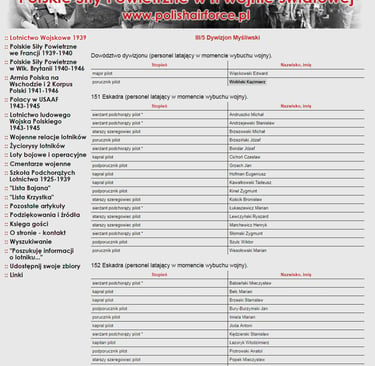
Polish III Air Regiment (Dyon III/5) with the list of pilots’ names and ranks (in Polish) of the 151 and 152 Fighter Squadrons at the outbreak of WWII in 1939. Note: Dyon III/5’s commander Major Edward Więckowski and second-in-command Lieutenant Kazimierz Woliński (highlighted in grey). Credit: [11].
Polish Air Force
On 15 June 1934 2Lt. K.J. Woliński was referred for a general pilot course to the Polish Air Force Officers Training Centre (CWOL No 1) in Dęblin, then in Lesser Poland (now Masovian Voivodship in Poland), where he learned the basics of pilotage until completion of the course on 15 of June 1935.
WWII: September 1939
On 4 September 1939 at 8.30 am two V-formations from 152 Fighter Squadron under the command of Lt. K.J. Woliński took off from Szpondowo operational airfield in order to protect the reconnaissance mission by the PZL 23B Karaś bombers of 41 Reconnaissance Squadron that bombed German troops in the Ciechanów area (around 100 km to the north of Warsaw). During the return from the mission the fighters of 152 Squadron also engaged with German troops from the 1 Cavalry Brigade. More details of the events on that day can be found e.g. in: [12,13]. Also see [6,14].
Three days later, on 7 September, K.J. Woliński led a V-formation of three aircraft from Wieruchów Airport (within Warsaw West County) to reconnoitre the Bug and Narew rivers defence lines against German attacks in north-eastern Poland. This flight brought information about German units forcing Polish defence troops at the River Narew towards Wyszków, a small town about 40 km to the north west of Warsaw. The next day 152 Fighter Squadron became part of Pursuit Brigade, and on 9 September the aircraft's V-formation commanded by K.J. Woliński encountered, without fighting, a Messerschmitt patrol near Lublin (one of the larger Polish cities and about 160 km to the south-east of Warsaw). In the afternoon of 9 September, commanding the squadron, K.J. Woliński was ordered to leave for Zielonka Airport (just north-east of Warsaw) with the task of protecting Warsaw bridges against enemy bombing [12,14]. On 12 September 1939 having lost contact with their Division, K.J. Woliński and the 152 Fighter Squadron joined the Toruń Air Regiment (Dyon) at Ostrożec Airport in Wołyń in Eastern Galicia, Poland (now Volhynia, a part of western Ukraine); during the September campaign, the command of the III/1 Fighter Squadron of the Pursuit Brigade as well as 111, 112 and 152 Fighter Squadrons was stationed at Ostrożec Airport. It is perhaps important to note that the combat trail of 152 Fighter Squadron in September 1939 encompassed various locations across Poland including: Wilno Porubanek Airport and Jaszuny Airport in the north-east; Warsaw region - Szpondowo, Kroczewo, Poniatów, Zielonka and Wieruchów Airports; south of Warsaw - Kierz Airport; east of Warsaw - Brześć nad Bugiem Airport; and in south-eastern Poland - Ostrożec and Litiatyn Airports. For more information see [12].
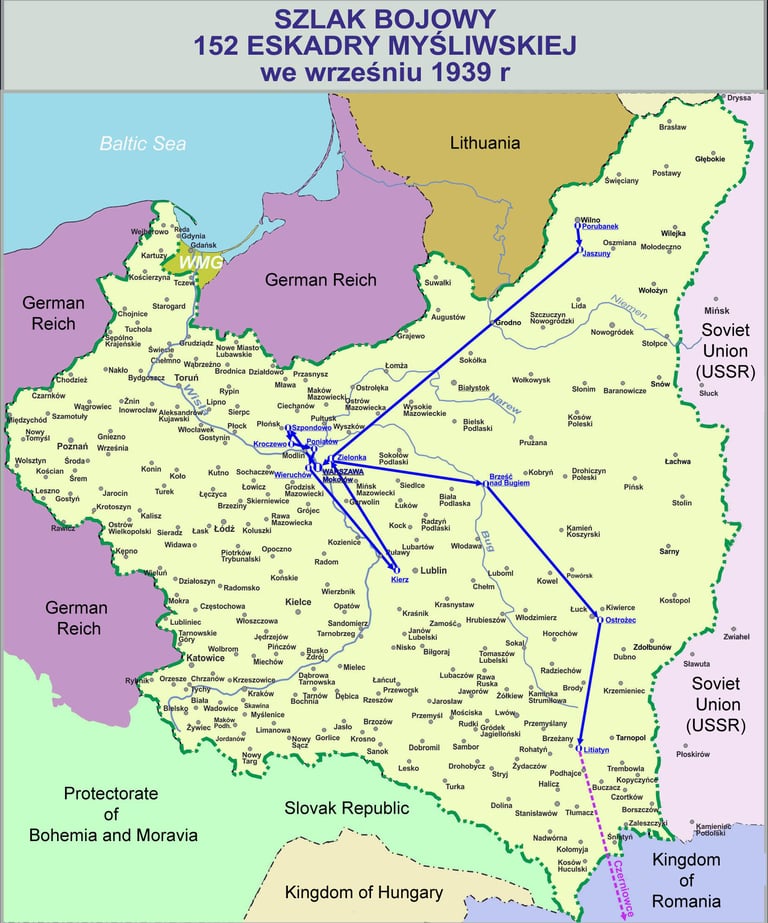

Map of Poland showing battle trail (straight blue lines) of the 152 Fighter Squadron in September 1939. Credit: [12,13].
From Poland to France via Romania
On the personal oral order of the commander colonel pilot Stefan Pawlikowski, Lt. K.J. Woliński and Lt. pilot Marian Imiela (together two planes PZL and P11c of 152 Fighter Squadron) took off from Litiatyn Airport (then in south-eastern Poland; now in western Ukraine) during the night of 17/18 September 1939. On 18 September 1939 at 4.45 am, K.J. Woliński fly-passed the Polish-Romanian border near the town Śniatyn (now Sniatyn in western Ukraine), and continued his flight until he reached Czerniowce (Černivci) Airport in the north of the Kingdom of Romania (now Chernivtsi in western Ukraine). On the same day he apparently also flew from the Airport Černivci to Jassy (Iaşi) Airport in the north-east of the Kingdom of Romania (now (Iaşi near the Romania–Moldavia border). Then on 19 September 1939, KJ Woliński flew to Galati Airport, Kingdom of Romania, where he passed over his plane and armaments to Romanian Army authorities. On 26 September 1939 in Bucharest, Romania, K.J. Woliński obtained his necessary documents including a passport provided by the Polish authorities.
On 9 October 1939 at 22.00 hrs he crossed the French border at Modane (in south-eastern France bordering with Italy), and on 10 October 1939 at 23.00 hrs he reported himself at the Rally Station in Paris.
Here the handwritten service report by Lieutenant Kazimierz J. Woliński ends with his signature and the date: Paris, 11 October 1939.
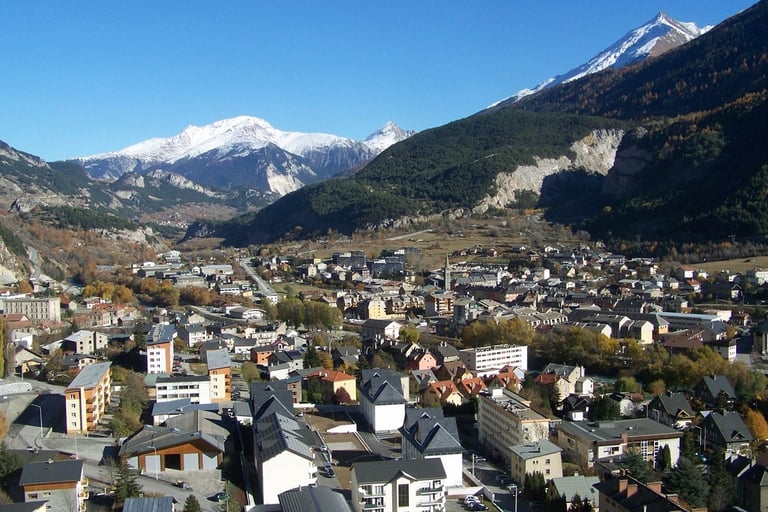

Modane (current view) in south-eastern France at the French-Italian border; town is surrounded by the Alps Mountains. Note that K.J. Woliński crossed the French border at Modane on 9 October 1939. In 1943 the town was heavily bombed by Allied bombers in order to destroy the railway station - an important centre of transit between France and Italy: Turin-Modane railway. For Allies bombing of Modane see [16]. Credit (Photo): [17].
There are still things one would like to know, for instance, how did K.J. Woliński travel from Romania to France? What route did he take to get there?
Beirut hint
In his report, K.J. Woliński did not mention the route he took between Bucharest and Paris. It would be interesting to know how he got to Paris. In Adam Zamoyski’s book “The Forgotten Few…” [18], there is a section dedicated to the circumstances the Polish pilots faced in Romania, after they left occupied Poland. We learn that after completing necessary interests at the Polish Embassy in Bucharest, they were ordered to get to the border posts and/or ports at Black Sea in order to continue their exodus to Greece or to Italy through Yugoslavia. One of the possibilities was to get to the Port of Balcic in the Black Sea (then in Romania; now Balchik in Bulgaria), embark there on a Greek-flagged coaster, the St Nicolas, and sail into Beirut (in Lebanon) on the Mediterranean, and then continue the trip possibly by sea to the French coast. In fact, Beirut was under the French Mandate at that time until Lebanon’s independence in 1943. This possible route for K.J. Woliński might partially agree with the version given by the “Niebieska eskadra…” (“Blue Squadron…”) [19], or with the description by Cumft and Kujawa (1989) [20]. In theory K.J. Woliński could have continued his journey by sea to the French coast and then finally reaching Paris. As on 26 September 1939 he was in Bucharest and on 11 October 1939 he reported in Paris, he had two weeks to complete his expedition. According to Zamoyski’s book [18], the coaster St Nicolas, with some 800 airmen on board, sailed from Balcic on the Black Sea on 15 October, arriving at Beirut on 25 October 1939. Since K.J. Woliński reported in Paris on 11 October 1939, he could not have travelled on these particular sailing dates of the St Nicolas; perhaps he embarked on an earlier trip by the St Nicolas - if there was one; or perhaps he embarked on another ship and not at the Port of Balcic but at one of the other Black Sea ports such as Constanza (Constanța) or Efori? Woliński reported crossing the French border in Modane; this is in Alps region in south-eastern France at the border with Italy. This also would mean that the route most likely taken by him from Romania (initially from Constanța?) was through Yugoslavia and Italy. It is perhaps interesting to note that other Polish pilots, for instance Lt. Robert Franciszek Janota from I/145 Polish Fighter Squadron, took this route from Romania; he also crossed the French border in Modane on 9 October 1939, and reported himself at the Rally Station in Paris on the next day – on the 10 October 1939 [21]. Apparently Lt. RF Janota travel to France together with other Polish Pilots, so it is also likely that one of them was K.J. Woliński.
Lyon-Bron Airport - located about 10 km east of Lyon (east-central France). K.J. Woliński reported himself to the Polish base when he arrived in France. Note that during WWII military activity replaced commercial traffic at the airport. For more details and credit (Photo) see: [23].
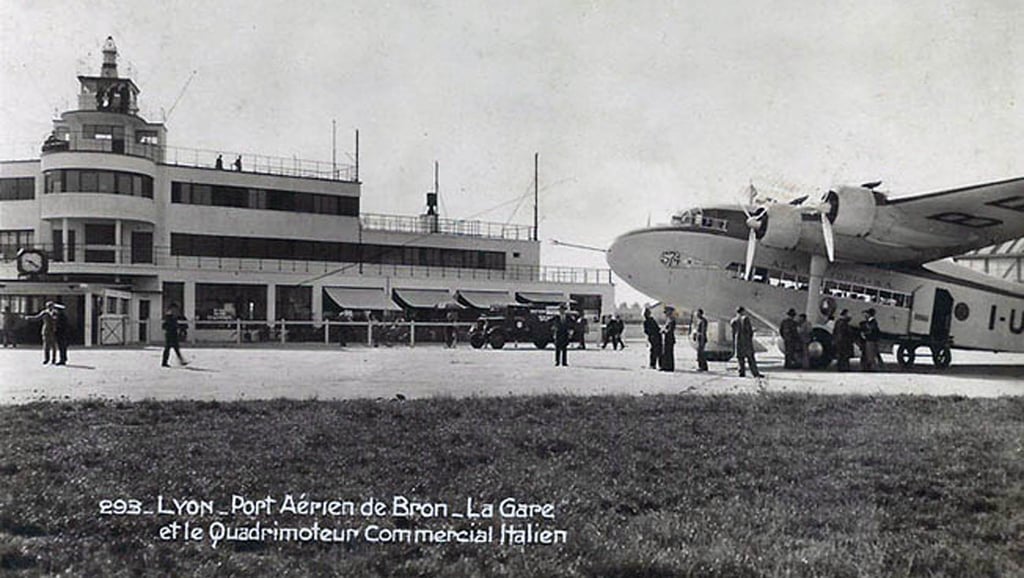

In France
Like other Polish pilots who reach France, K.J. Woliński registered at the Lyon-Bron base located about 10 km east of Lyon (east-central France). There he was assigned to Captain Tadeusz Rolski’s Group of 22 pilots and together they went for training (on Caudrons C 714 aircraft) to Saint-Étienne (south-west of Lyon) on 24 May 1940. Then on 31 May, Rolski’s Group returned to Lyon, to Mions Airport. After that no details are known of K.J. Woliński’s actions in France, and not until his arrival to Great Britain in September 1940. But according to information about the Polish Air Force during WWII [22] we learn: "The Polish pilots were deployed to various French squadrons, flying on all types of French fighters, but mostly on the MS-406. After the surrender of France, many of these pilots managed to escape to Britain to continue the fight against the Luftwaffe”. Indeed on the capitulation of France in June 1940 (the armistice was signed on 22 June 1940 with effect on midnight 25 June 1940), K.J. Woliński was evacuated to Great Britain. In reality, on 19 June 1940 due to inefficient French logistics and policies, General Władysław Sikorski – commander-in-chief of Polish Armed Forces in France - instructed all Polish forces in France to make for the ports of: Brest, St-Malo, La Rochelle, Bordeaux, St-Nazaire, Bayonne or St-Jean-de-Luz, where ships were ready to take them to Britain (see: p. 53 in [18]).
Arrival in Great Britain
K.J. Woliński arrived in Great Britain on 26 June 1940, and came under British command with effect from 1 July 1940; on 2 July he took a posting at the Royal Air Force (RAF) Station in Blackpool (at the Irish Sea coast of northwest England). Then on the formation of the Polish Air Forces (PAF) under British command he joined the Force with effect from 5 August 1940. On 4 September 1940 K.J. Woliński joined the 306 Polish Fighter Squadron at the RAF Church Station (currently Leeds East Airport) in a village Church Fenton in North Yorkshire – about 20 km east of Leeds. It appears that on 26 September K.J. Woliński made his first solo flight, while on 19 October with British officer F/Lt Edward Alan Tennant and P/O Jan Czapiewski (P-0706) he made his first patrol mission, which was over Liverpool.
On 7 (or 8) November 1940, the 306 Polish Fighter Squadron became operational (the Squadron roster was crystallized in mid-November 1940 and included K.J. Woliński among the first [24]. In fact some of their Hurricane missions took actions earlier – in September/October 1940, as it was mentioned above. On 7 November 1940 (until 3 April 1941) K.J. Woliński as well as the 306 Polish Fighter Squadron with their Hurricanes aircraft was re-located (starting from 2 November) to RAF Station in Ternhill - a village in Shropshire (a West Midlands region of England bordering Wales to the west), from where they flew their operational missions [25,26].
On 10 February 1941, F/O Woliński and also Sgt. Marek Słoński-Ostoja and Sgt. Bolesław Turżański were assigned to the 315 Polish Fighter Squadron (“Dębliński”- equipped with Hurricanes) then based in the RAF Station Acklington located some 5 km south-west of the town Amble (Northumberland). But in March 1941, 315 Fighter Squadron was moved to RAF Speke, Liverpool (currently Liverpool John Lennon Airport), where it made frequent patrols over naval convoys as part of No. 9 Group RAF.
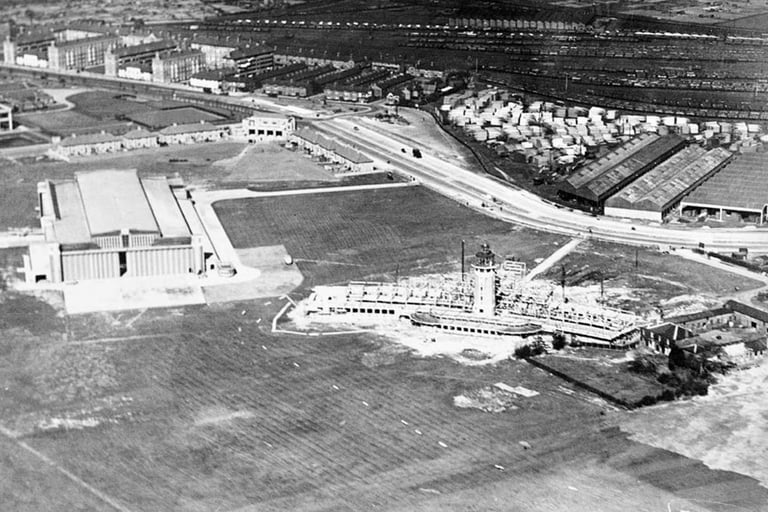

RAF Liverpool Speke Airport (now Liverpool John Lennon Airport). 315 Polish Fighter Squadron was based there in March 1941 (when moved from RAF Station Acklington); here 315 Squadron was involved in patrols over naval convoys. Credit (Photo): [27,28]
Training flight accidents March 1941
Then on 27 March 1941, at 10 o'clock the 315 Squadron, which included: F/Lt Władysław Szulkowski, F/O Eugeniusz Fiedorczuk, Sgt. Edward Paterek, F/O Kazimierz J. Woliński, P/O Tadeusz Hojden and Sgt. Piotr Zaniewski took off from Speke Airport for a flying practice, but then performed an operational patrol. There were bad weather conditions, and during the patrol flight Fl/Lt Szulkowski collided with Sgt. Paterek (a propeller from Sgt. Paterek’s Hurricane struck the tail of Fl/Lt Szulkowski’s Hurricane); unfortunately both aircraft crashed into the sea and both pilots died. F/O K.J. Woliński’s plane suffered an engine problem (apparently due to lack of fuel) and he had to ditch in the sea near Fleetwood (a coastal town in Lancashire) but luckily was rescued by a trawler. His plane however was not retrieved and was deleted from the state of the Squadron. In fact only F/O Fiedorczuk returned from this tragic patrol flight to base. For more information see [26]. According to some sources (see: http://polishsquadronsremembered.com/315/41/mar_27_41.htm; year 1941, Mar 27 - “Patrol over Preston in a force of six Hurricanes. Four a/c and three pilots lost”), the take-off of Hurricanes of this tragic training event was from the emergency airfield Squires Gate near Blackpool.
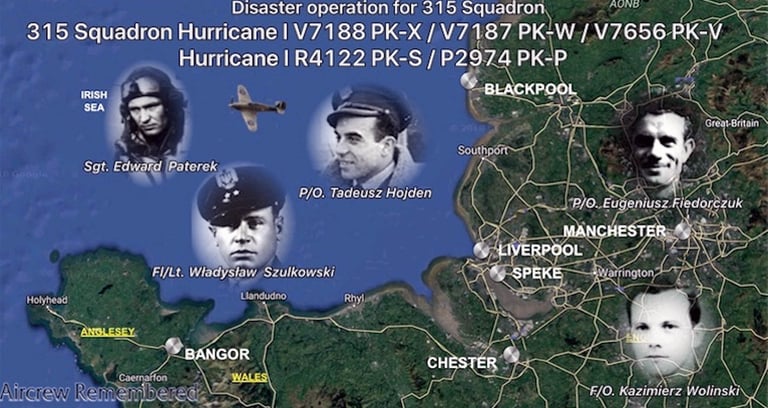

315 Fighter Squadron disaster during a training operation in difficult weather conditions over the Irish Sea after taking off from RAF Speke Liverpool on 27 March 1941. Sgt. E. Paterek and FL/Lt W. Szulkowski had an air accident, crashed to the sea and died, while K.J. Woliński was forced to ditch (engine failure) but was rescued; P/O T. Hojden was missing (believed killed), while P/O Fiedorczuk returned to the base unharmed. Credit (Photo): [29]
In July 1941, 315 Fighter Squadron was moved to RAF Northolt in West London (around 10 km of London Heathrow Airport). Now the Squadron was equipped with Spitfires.
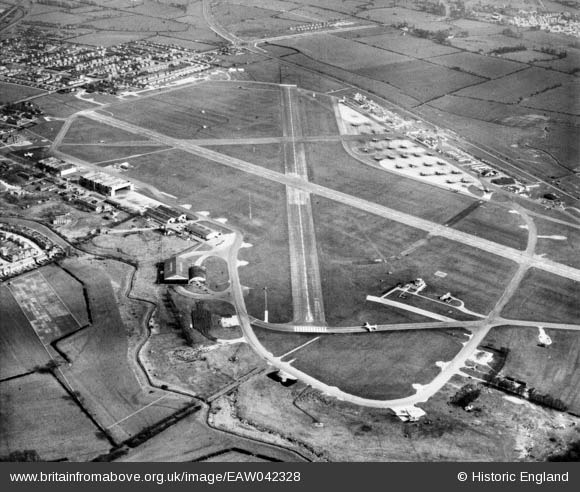

RAF Northolt, Hillingdon, 1952. Credit: “Britain from Above”. Reference: EAW042328 ENGLAND (1952) (https://www.britainfromabove.org.uk/image/eaw042328)
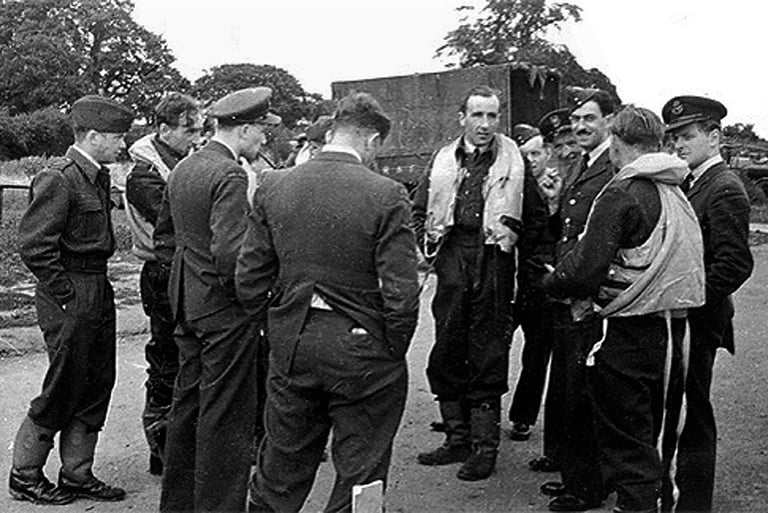

July 1941, Northolt, Great Britain. Pilots of 315 Polish Fighter Squadron after a sweep.
Left to right: F/O Kazimierz J. Woliński, S/Ldr (Commander) Stanisław Pietraszkiewicz, F/O Józef Czachowski, F/Lt Bronisław Mickiewicz (back), F/O Jan Falkowski (centre), medical F/O Józef Jarosz, F/O Jerzy L. Chrzanowski, F/O Paul A. Harding (a British Officer Volunteer attached to 315 Squadron from May to October 1941), F/O Michał Cwynar; and an unidentified pilot (side-back). Public domain. Credit (Photo) [30]. Also see [31,32]
Fighting over France and Belgium
On 22 July 1941 F/O Woliński of 315 Squadron made his first flight from Great Britain to France and on 7 August he took part in action over France. The squadron carried out an action over Nieuport (Nieuwpoort) on the Belgium Flanders coast, and St. Omer – Gravelines between Calais and Dunkirk (Dunkerque) on the coast of northern France. On 29 August 1941 F/O Woliński’s Bf109 was damaged over Hazebrouck [33], a French town east of Boulogne in the arrondissement of Dunkirk. Hazebrouck was an important military target during WWII, as it had been during WWI.
Killed in action
On 16 September 1941 at 17.45, Squadron 315 (12 aircraft led by S/Ldr Stanisław Pietraszkiewicz) together with Squadrons 306 and 308 took off and launched a sweep; the flight route led from Gravelines via St.Omer to Folkestone. The Polish Wing flew at an altitude of 30,000 feet, and a fight developed with German fighters (about thirty German Messerschmitts) over St. St. Omer, a small town east of Boulogne. Tragically, F/O Kazimierz J. Woliński was shot down (his Spitfire VB PK-T AB923) and killed by a Messerschmitt Bf 109; this happened over Mont Lambert just east of Boulogne.
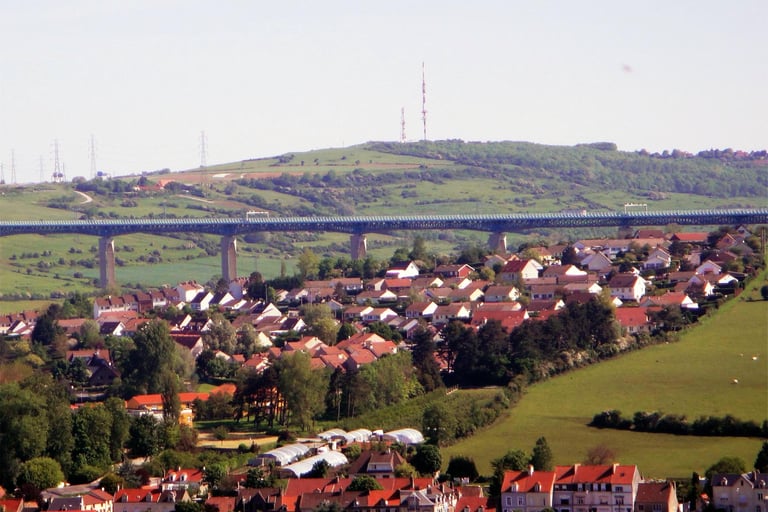

Mont-Lambert (189m above sea), the highest hill in Boulogne region (east of Boulogne); here it is seen from the village d'Écault. The hill was strategically very important: it was a key position of the German defences. It was here over Mont Lambert where F/O K.J. Woliński’s Spitfire VB PK-T AB923 was shot down and he was killed on 16 September 1941. Note that on 17 September 1944, Mont-Lambert (its enforcement) was very heavily bombed by the Allies. Credit (Photo) [34]. Also see [35].
F/O Kazimierz J. Woliński (12/5/1910-16/9/1941)
was buried at the De L'Est cemetery in Boulogne.
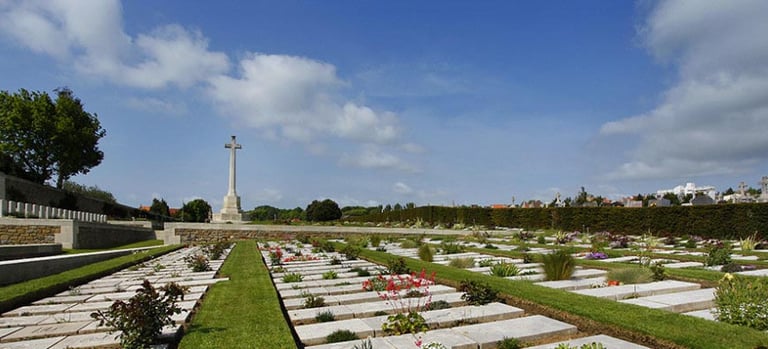


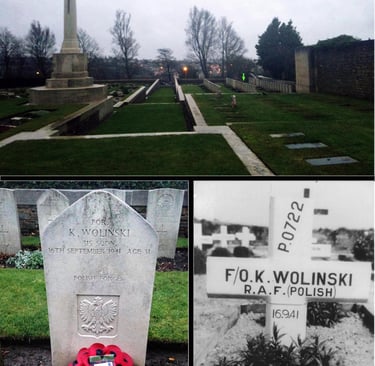
A fragment of Boulogne Eastern (De L’Est) Cemetery with a Cross of Sacrifice seen just before Christmas 2019. The Cemetery is the resting place of 5801 British Commonwealth soldiers, including 5577 from 1914-1918 (WWI), and 224 from World War II. There are 11 graves of Polish Air Force pilots: 5 resting places of one full bomber crew, and 6 of fighter pilots. One of the latter is the resting place of fighter pilot F/O K.J. Woliński (location of the grave is indicated by a green arrow in upper photo). Note K. Woliński’s current grave (lower left) and the original grave (No 284) with the cross and pilot’s identification No P0722 (lower right). Current Burial/Commemoration Details: Plot XIII Row B Grave 14 at Boulogne Eastern Cemetery, France. NB The Cemetery is full of flowers in the spring and summer (see previous photo).
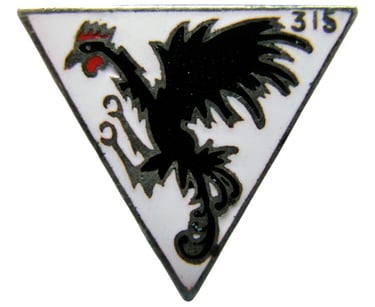

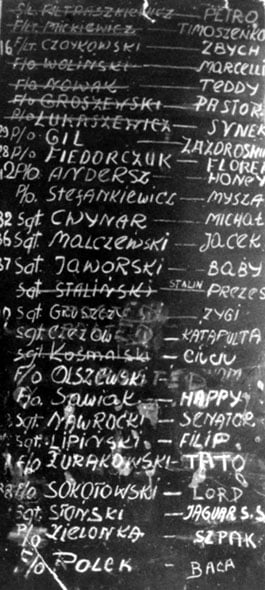

Badge of the 315 Polish Fighter Squadron and the board with chalk-written names and nicknames of pilots of 315 Squadron. The crossed out names are fallen (killed in action), lost or taken prisoners. Note the 4th from the top crossed out name is F/O Woliński. Credit (Photos) [30].
Medal Entitlements
On 31 October 1947 in London, the Head of the Main Liquidation Commission of the Polish Armed Forces - Colonel Mieczysław Sulisławski, posthumously decorated F/O Kazimierz Jan Woliński with the Silver Cross of “Virtuti Militari” Class V and “Cross for Valour”.
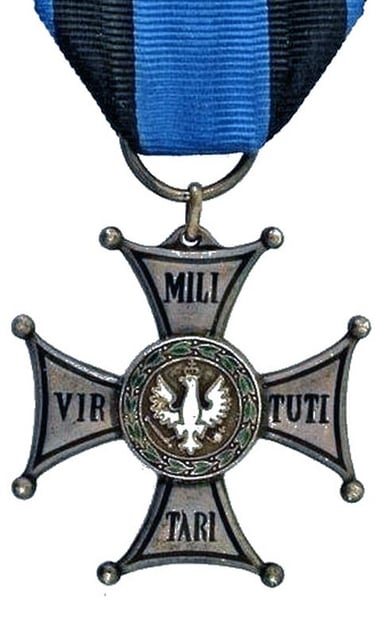

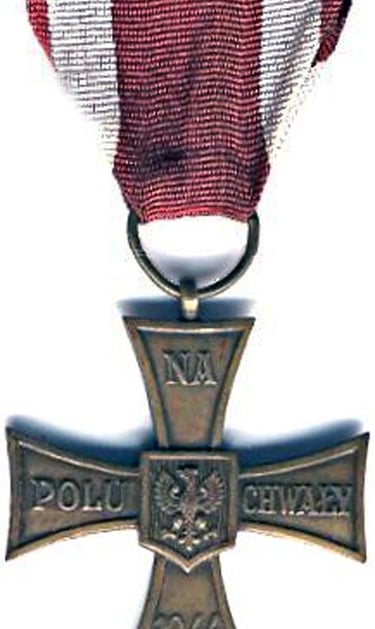

Silver Cross of “Virtuti Military” Class V
“Cross for Valour“
Other Polish Entitlements
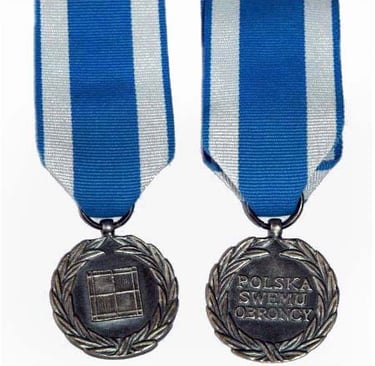

Air/Aviation Medal (1939-1945)
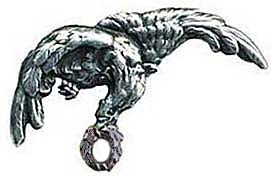

Air Force Pilot Wings Badge: : gapa
British Entitlements - Campaign Medals
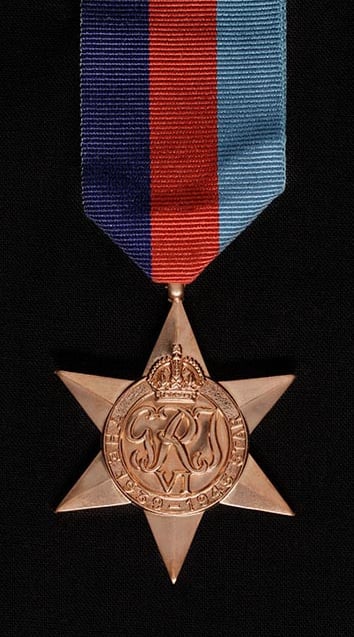

1939-1945 Star
(RAF operational service)
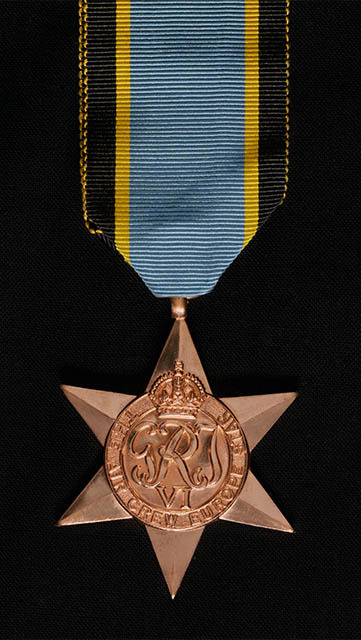

Air Crew Europe Star (Service in World War Two)
Memorials Honouring Polish Airmen
The participation of Pilots of Polish Air Forces in the defence of Poland in 1939 and then fighting in France and in particular in Great Britain, were recognised (after a delay) both in Poland and in Britain. In Poland, the National Memorial to the Polish Airmen Who Fell in World War II 1939-1945, including Polish Air Forces in France 1939-1940 and in Great Britain 1940-1945 was unveiled on August 27, 2003 by the President of the Republic of Poland.
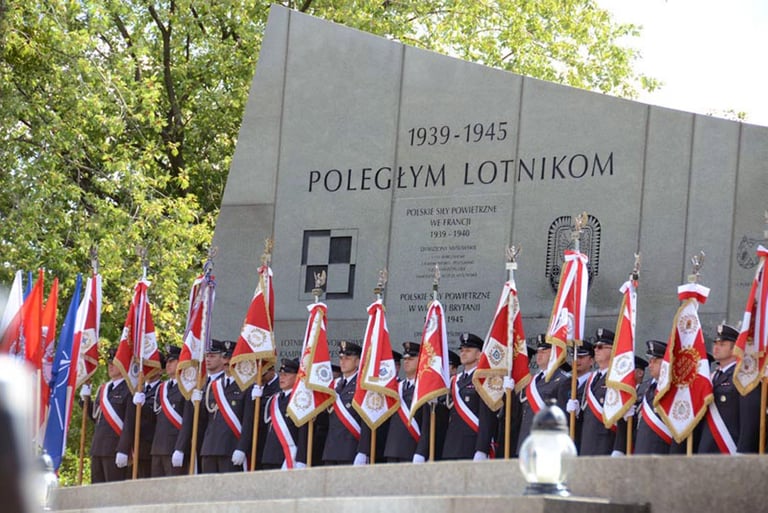

Warsaw, Poland: National Memorial to the Polish Airmen Who Fell in WWII 1939-1945, including Polish Air Forces in France 1939-1940 and Polish Air Forces in Great Britain 1940-1945. This memorial is located in Pole Mokotowskie – the old Mokotów Airport in Warsaw (see photo on next page) from where the first heroic Polish pilots set out to fight the invader in the early days of World War II. The memorial was unveiled on August 27, 2003 by the President of the Republic of Poland, Head of the Polish Armed Forces, then Aleksander Kwaśniewski. Among the list of fallen airmen is listed the name: Kazimierz Woliński. Credit (Photo): [37].
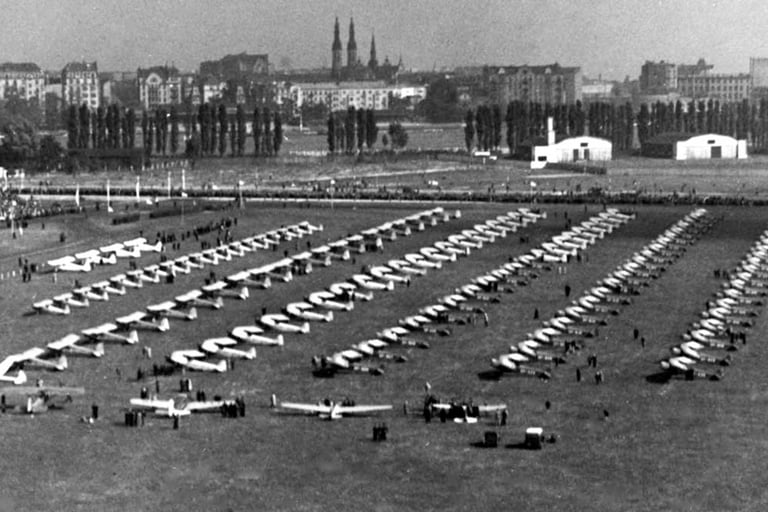

Warsaw, a view of Mokotów Airport on 26 September 1937. Ceremony of handing over to the Polish Army over 126 aircraft (including RWD-8, 13, 16) funded by public donations [38, 39]. It is important to mention three very talented young designers, Stanisław Rogalski, Stanisław Wigura and Jerzy Drzewiecki, whose names formed the RWD acronym for the planes. They started work while studying at Warsaw University of Technology in 1925. Later they designed a variety of planes including: acrobatic, acrobatic-trainer, light sport, passenger, observation, touring, and ambulance planes.
Incidentally, Mokotów Airport operated from 1910 to 1947 and played an important role in 1939 during the September campaign. 152 Fighter Squadron, incorporated into the Pursuit Brigade, and the 41 Reconnaissance Squadron were temporarily stationed there. On 2 September 1939 the Liaison Squad of the Supreme Aviation Commander was formed, and from 9 September the Warsaw Defence Air Group. After the capitulation of Warsaw, the airport was taken by the Germans, mainly by the anti-aircraft defence units, so aviation activity was very limited. After closure of the Airport after 1947, it became a park - Pole Mokotowskie. The history of the airport [see: 40] is commemorated now by the obelisk located in the central part of the park.
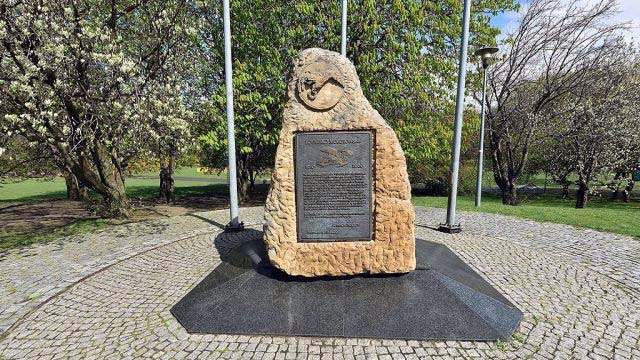

Obelisk commemorating Mokotów Airport in Warsaw.
Credit (Photo): [41].
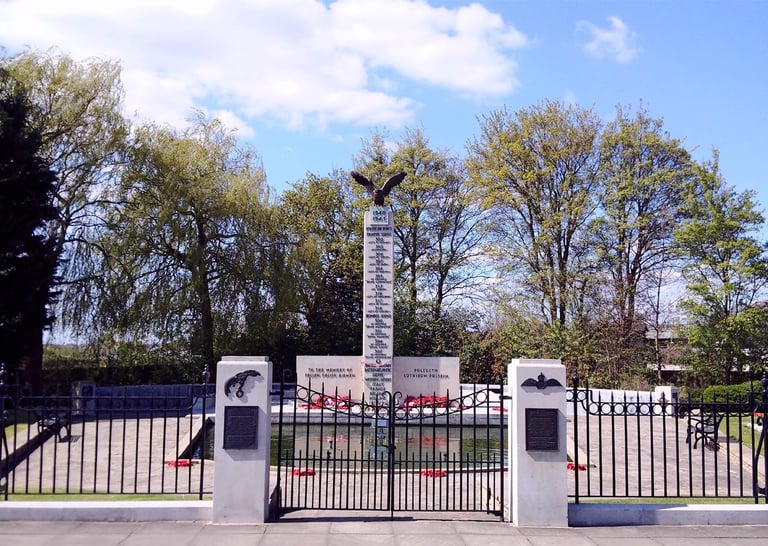

The Polish War Memorial in South Ruislip, the Borough of Hillingdon, West London: near RAF Northolt Airfield. This war memorial commemorates Polish Airmen who served in RAF as part of the Polish contribution to WWII efforts and defence of Great Britain. The monument shows the Squadrons’ names and their numbers (below); Monument panels show the names of those remembered: Panel 78 shows F/O K. WOLIŃSKI. Credit (Photos): main [42], lower left [43], and lower right [44].
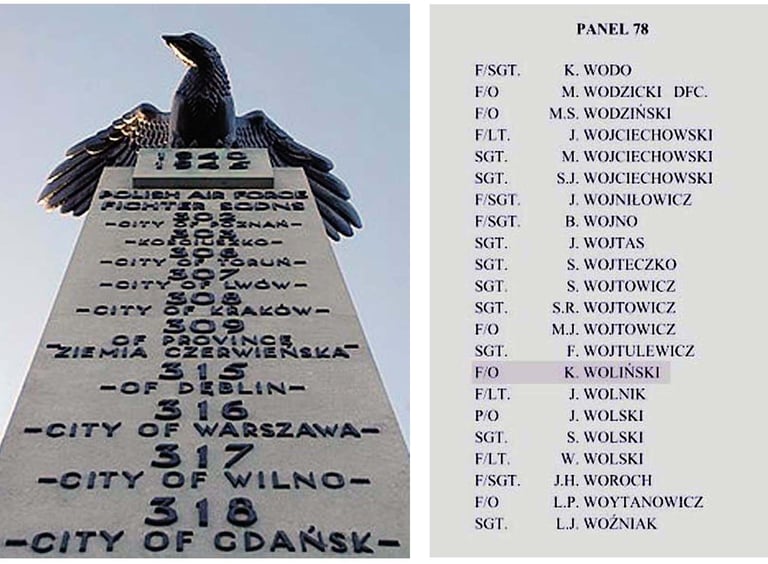

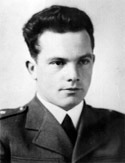

P-0722 Flying Officer Kazimierz Jan Woliński
(1910 – 1941)
R.I.P
Post Scriptum
In her letter 28th July 1946, Kazimierz's mother Nela wrote to my mother about the lack of information regarding his death: “Still we have no information about Kazimierz; we continue our efforts and Mieczysław too; we expect some news in August – necessarily something? I am missing him extremely. We thank God that somehow he kept Mieczysław safe for us; he is our support now”. (Mieczysław was Kazimierz’s brother).
It is sad that 5 years after K.J. Woliński’s death in action, and a year after the end of WWII, his family and in particular his mother had no information relating to the circumstances of his death in action. Why was that? It can be said that Polish officers serving in the West, including those pilots defending Britain therefore also fighting for Polish freedom, were frequently not welcomed or even prosecuted on return to post-war Poland. After WWII many Polish army personnel (over 17,000 air personnel including women were active in Polish Air Forces in Britain during WWII) settled in the West including in Great Britain. As a matter of interest, the UK Ministry of Defence (MOD) has the service records of Polish Personnel who served with the Polish Free Forces and Royal Air Force. Now there is a parliamentary debate initiated by Daniel Kawczynski, MP in the House of Commons, which hopefully will lead to the transfer of the service records of Polish Personnel to the Polish authorities; this would include the transfer of around 10,000 records covering correspondence initiated by the service ministries after the war, telling of their efforts to repatriate the personal effects of Polish personnel killed during the war. The records would be held at the Central Military Archive in Rembertów near Warsaw, Poland. See: House of Commons Library, Debate Pack Number CDP-0168 (2019), 27 June 2019 “Polish contribution to the UK war effort in World War Two”, Westminster Hall, Tuesday 2 July 2019 (https://researchbriefings.files.parliament.uk/documents/CDP-2019-0168/CDP-2019-0168.pdf).
Further in the same the letter of 28th July 1946, Kazimierz's mother asks my mother about my other cousin - Jerzy Grek – “how did he get to London?” During WWII Jerzy Grek was an officer with General Anders' Polish Army fighting alongside the British in Africa and Italy (including in the Battle of Monte Cassino). He eventually settled in Liverpool. But this is a different story – for another time...
Here the story about Flying Officer Kazimierz Jan Woliński ends, at least for now. There might be some oversights as to details such as exact dates or nomenclature. This is because the relevant information at source is not always clear or available, even in the light of the vast quantity of information written about the Polish Armed Forces in the West, including the Airmen during WWII, and in particular in relation to their crucial missions in the Battle of Britain. K.J. Woliński’s name is mentioned in various databases and army records including those of The Forces War Records, UK. Brief accounts of K.J. Woliński’s life are commemorated e.g. in “Niebieska Eskadra” [19]; “Księga lotników polskich poległych, zmarlych i zaginionych” by O. Cumft and H.K. Kujawa [20]; or “Polskie Siły Powietrzne w Wielkiej Brytanii Lista Lotników” (new - third edition as: “Polskie Siły Powietrzne w Wielkiej Brytanii 1940-1947: Łącznie z Pomocniczą Lotniczą Służbą Kobiet (PLSK-WAAF)” by Anna Krzystek and Tadeusz J Krzystek [45].
It is hoped, however, that the information provided here broadens the view on the short life of Kazimierz J. Woliński, and is as accurate as possible. Necessary corrections and upgrades to the text will be made if any new facts come to light.
I trust that if K.J. Woliński’s relatives were still with us, in particular K.J. Woliński’s mother and brother Mieczysław, they would accept this short story about Flying Officer Kazimierz Jan Woliński, a humble young man who fought and died for three countries: Poland, Great Britain and France.
Prof Andrzej Loesch PhD, DSc, FRSB
London, UK
September 2020
Sources
The author acknowledges all the sources of the material used in this presentation, hence making the account of K.J. Woliński’s short life much more visible to the reader, in particular that of a younger generation interested in the history of WWII. Several photos used in this presentation are in the public domain; others were used as for the educational purposes.
P-0722-Flying Officer Kazimierz Woliński. Ref: 3/P-0722/APC/POL/K. The Ministry of Defence, APC Polish Enquires, RAF Northolt, UK. 25 November 2004.
The National Digital Archive, Warsaw, Poland https://www.szukajwarchiwach.gov.pl/en/jednostka/-/jednostka/5939527/obiekty/449537
File: PWS-26 w CWOL.jpg. https://commons.wikimedia.org/wiki/File:PWS-26_w_CWOL.jpg;
Narodowe Archiwum Cyfrowe https://audiovis.nac.gov.pl/obraz/62713/845dca32771d0ec6165a9319834dee95/
Media Drum World: https://mediadrumworld.com/2017/05/22/8813/.
Jerzy Pawlak (1989) Polskie Eskadry w latach 1918-1939. Wydawnictwo Komunikacji I Łączności. Warszawa: ISBN 83-206-0760-4.
Franciszek Grabowski (2017) Skalski: Against All Odds: The First Allied Ace of the Second World War. Fonthill Media Limited Stroud, UK.
Wiktor Porembski (2017) Polskie lotnictwo w przededniu II wojny światowej. Plany i realia https://naszahistoria.pl/polskie-lotnictwo-w-przededniu-ii-wojny-swiatowej-plany-i- realia/ar/12028082
Port lotniczy Wilno-Porubanek. Polskie plany konsolidacji państw w regionie EuropyŚrodkowej. Polish Club Online: since 1998. https://www.polishclub.org/2019/08/18/port- lotniczy-wilno-porubanek-polskie-plany-konsolidacji-panstw-w-regionie-europie-srodkowej/
Mapa: Szlak Bojowy 152 Eskadry Myśliwskiej we Wrześniu 1939 r https://upload.wikimedia.org/wikipedia/commons/6/64/152_esk_mysl.png
Polskie Siły Powietrzne w II Wojnie Światowej, III/5 Dywizjon Myśliwski together with the Sources (Zródła) listed at the bottom of the image page. http://www.polishairforce.pl/dywiii5lotnicy.html
152 Eskadra Myśliwska. https://pl.wikipedia.org/wiki/152_Eskadra_Myśliwska.
41 Eskadra Rozpoznawcza. https://pl.wikipedia.org/wiki/41_Eskadra_Rozpoznawcza.
Jerzy Pawlak (1991) Polskie Eskadry w Wojnie Obronnej 1939. Wydawnictwo Komunikacji I Łączności. Warszawa. ISBN 83-206-0795-7.
Polish 152nd Fighter Escadrille. https://en.wikipedia.org/wiki/Polish_152nd_Fighter_Escadrille
16/9/43 Attack Against Targets at Modane – Railway Yards. https://75nzsquadron.wordpress.com/16943-attack-against-targets-at-modane-railway-yards/
Modane. https://fr.wikipedia.org/wiki/Modane,
https://fr.wikipedia.org/wiki/Modane#/media/Fichier:Modane_(depuis_Loutraz)JPG
Adam Zamoyski (1995) The Forgotten Few: The Polish Air Force in the Second World War. John Murray (Publishers) Ltd, London.
Niebieska eskadra – groby, cmentarze, pomniki, miejsca pamięci polskich lotników. https://www.niebieskaeskadra.pl/?control=8&id=1373&title=kazimierz-wolinski
Olgierd Cumft, Hubert Kujawa (1989) Księga Lotników Polskich Poległych, Zmarłych I Zaginionych 1939 – 1946. MON, Warszawa. ISBN-10: 8311073295, ISBN-13: 978-8311073296
Robert Janota: Życiorysy Lotników: Polskie Siły Powietrzne w II Wojnie Światowej. http://www.polishairforce.pl/janota.html
Polish Air Force. https://en.wikipedia.org/wiki/Polish_Air_Force#1939
Lyon-Bron 1939-1945: The parenthesis. https://guerretombeeduciel.businesscatalyst.com/lyon-bron-1939-1945.html
Wilhelm Ratuszynski: History of No. 306 "City of Torun" Polish Fighter Squadron. © Polish Squadrons Remembered. http://www.polishsquadronsremembered.com/306/306story.html
Jefford C.G. (2001) RAF Squadrons, a Comprehensive Record of the Movement and Equipment of all RAF Squadrons and their Antecedents since 1912. Shrewsbury, Shropshire, UK: Airlife Publishing, ISBN 1-84037-141-2.
Robert Gretzyngier (2001) Poles in Defence of Britain: A Day-by-Day Chronology of Polish Day and Night Fighter Pilot Operations: July 1940 – June 1941. Grub Street Publishers, London.
Abandoned Forgotten & Little Known Airfields in Europe. https://www.forgottenairfields.com/airfield-liverpool-speke-airport-1198.html
Speke: Liverpool-United Kingdom. http://spekeliverpool.blogspot.com/2012/06/these-are-some-of-pictures-that-were.html
Aircrew Remembered. Archive Report: Allied Forces. http://aircrewremembered.com/szulkowski-wladyslaw.html
Polskie Siły Powietrzne w II Wojnie Światowej (w Wielkiej Brytanii 1940-1946). http://www.polishairforce.pl/dyw315zdj.html
Flickr: ww2images Archives: Polish Fighter Pilots: Image Ref: A10391R. https://www.flickr.com/photos/ww2images/6902740995/in/photostream/
Dunkirk 1940: The Before, The Reality, The Aftermath. The Royal Air Force. http://dunkirk1940.org/index.php?&p=1_118
John Foreman (2005) RAF Fighter Command: Victory Claims: Of World War Two. Part Two: 1 January 1941-30June 1943. Red Kite, Walton-on-Thames, England.
Mont Lambert. https://fr.wikipedia.org/wiki/Mont_Lambert
Musee De La Résistance eenligne 1940-1945. http://museedelaresistanceenligne.org/media4128-Reddition-de-la-fortification-du-Mont- Lambert-Saint-Martin-Boulogne.
Image 1 de 1: Boulogne Eastern Cemetery - Boulogne-sur-Mer / Anne-Sophie Flamen. http://www.remembrancetrails-northernfrance.com/trails/the-allies-logisitics-base-on-the- channel-coast/boulogne-eastern-cemetery-boulogne-sur-mer.html (site temporarily offline 6 Nov 2024)
Polish National Security Bureau. https://www.bbn.gov.pl/pl/wydarzenia/4057,Swieto-Lotnikow.html
Kurier Wileński Year XIV, No 266 (4228), 27 September 1937.
History of Poland 1914-1939. National Digital Archive (Call number: 1-W-3072-1).
Lotnisko Mokotowskie. https://pl.wikipedia.org/wiki/Lotnisko_mokotowskie
Obelisk upamiętniający lotnisko na Polu Mokotowskim. Photo: Adrian Grycuk. https://pl.wikipedia.org/wiki/Lotnisko_mokotowskie#/media/Plik:Obelisk_lotnisko_mokotowskie_Pole_Mokotowskie.jpg
File:Polish War Memorial London.jpg (Photo: Author: Romazur). https://commons.wikimedia.org/wiki/File:Polish_War_Memorial_London.jpg
Polish War Memorial. https://www.wikiwand.com/en/Polish_War_Memorial
The Polish War Memorial at Northolt U.K. showing the names of those remembered. Compiled in 2006 by: Philip J. Duerden, Ruislip, United Kingdom Jos van Alphen, Dorst, the Netherlands. memorial Northolt versie 2007 (pagina 1 van 25). http://www.polishwargraves.nl/info/mem.northolt.2007.pdf
Anna Krzystek, Tadeusz J Krzystek (2012) Polskie Siły Powietrzne w Wielkiej Brytanii 1940- 1947: Łącznie z Pomocniczą Lotniczą Służbą Kobiet (PLSK-WAAF) [Eng.: “Polish Air Force in Great Britain in 1940-1947: Including the Women's Auxiliary Air Force Services (PLSK- WAAF)”] STRATUS, Sandomierz, Poland. ISBN 9788361421955. [tzw. Lista Krzystka].
Further reading
Royal Air Forces Commands. Porucznik Kazimierz WOLINSKI (P/0722) of the Polish Air Force. http://www.rafcommands.com/database/wardead/details.php?qnum=122941
315 Squadron-1941 events – Polish Squadrons Remembered http://www.polishsquadronsremembered.com/315/1941szy.html, year 1941, Mar 27 - “Patrol over Preston in a force of six Hurricanes. Four a/c and three pilots lost” http://www.polishsquadronsremembered.com/315/41/mar_27_41.html
The Merseyside Few: Liverpool, Wirral and the Battle of Britain. Władysław Szulkowski: Death and Funeral. https://themerseysidefew.com/pilots/wladyslaw-szulkowski/death-and-funeral/
315 Squadron 1941 events – Polish Squadron Remembered (An appendix issue of Britain's war stamps) http://polishsquadronsremembered.com/315/1941szy.html, http://polishsquadronsremembered.com/315/41/sep_13_41.html
Traces of War: Lista Krzystka. https://www.tracesofwar.com/persons/83810/Woli%C5%84ski-Kazimierz.html
PZL P.11. https://en.wikipedia.org/wiki/PZL_P.11
Izydor Koliński (1978) Regularne jednostki ludowego Wojska Polskiego (lotnictwo). Formowanie, działania bojowe, organizacja i uzbrojenie, metryki jednostek lotniczych. Krótki informator historyczny o Wojsku Polskim w latach II wojny światowej. Cz. 9. MON Warszawa.
Łukasz Łydżba (2010) Wileński III/5 Dywizjon Myśliwski. Vesper. Poznań. ISBN 978-83-7731-019-9.
Jerzy Pawlak (1982) Polskie Eskadry w Wojnie Obronnej 1939. Wydawnictwo Komunikacji i Łączności, Warszawa. ISBN 83-206-0281-5.
152 Eskadra Myśliwska. https://pl.wikipedia.org/wiki/152_Eskadra_My%C5%9Bliwska
Kronika 317 Wileńskiego Dywizjonu Myśliwskiego, cz. I. W: Akta Polskich Sił Powietrznych Na Zachodzie 1935-1947, sygn. LOT.A.V.55/47 I [on-line]. Instytut Polski i Muzeum im. gen. Sikorskiego w Londynie. [dostęp 2017-03-03].
